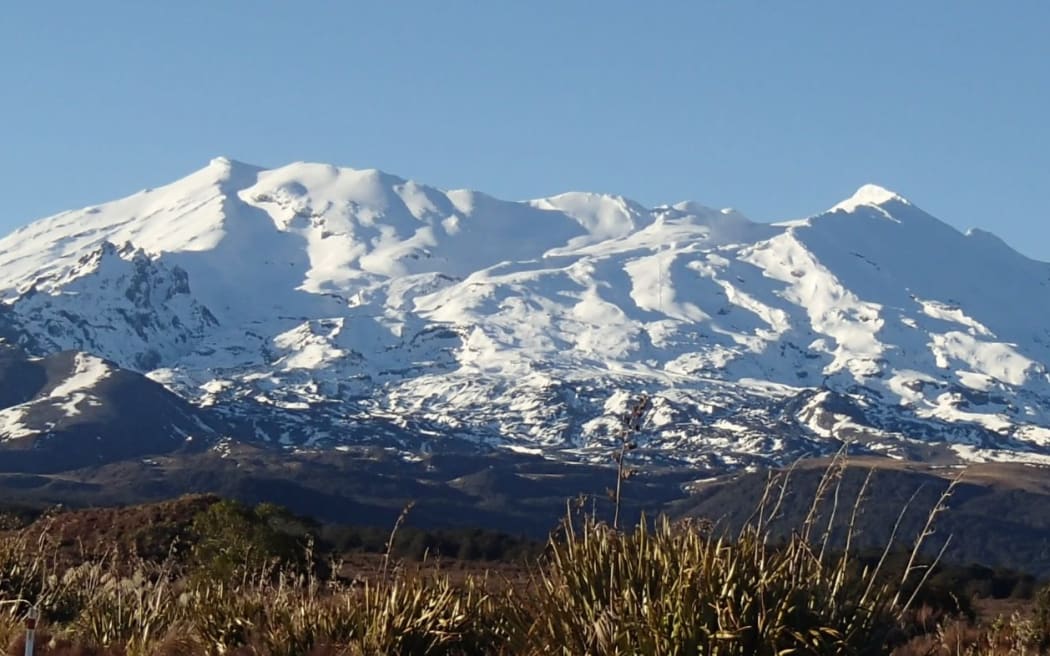
National Park is located near Mt Ruapehu in the central North Island. Photo: LDR
A bid by a central North Island iwi to change the name of National Park back to Waimarino has been accepted by the Ngā Pou Taunaha o Aotearoa NZ Geographic Board.
The iwi Uenuku has called for the ski and tourist village and its railway station, located by Mt Ruapehu, to revert to its previous names, Waimarino and Waimarino Railway Station.
The iwi says the historic Waimarino Pā was located on the site currently referred to as National Park Village.
A three-month public consultation on the name change proposal will open on Tuesday, 7 November.
Waimarino was the original name for the village and railway station until 1926 when the station was renamed National Park Station by NZ Railways after a request from Waimarino County Council.

It is not known when the Geographic Board approved changing the name of the Waimarino settlement to National Park. In 1968, the council was still referring to Waimarino Village and in 1973 a LINZ map named the village as Waimarino.
Uenuku researchers told the Owhango-National Park Community Board in August that the National Park name was “not official” and was “recorded” rather than approved.
On 29 July, Uenuku signed a Treaty of Waitangi settlement with the Crown as part of the iwi collective Te Korowai o Wainuiārua.
Two days later, Uenuku and the iwi collective gained community board support “in principle” for the name change and public consultation.
Former Ruapehu District councillor Peter Pehi told the community board that his whānau were “ahi kaa”, having lived in the area for generations.
“All through the old history it was referred to as Waimarino, never National Park … it has always been Waimarino in oral tradition.”
Koroua Shane Isherwood said Waimarino – meaning calm waters – was “the most beautiful name”.
“Growing up as a child, that’s all I knew. It was only in the ’20s it got changed to National Park. It was only a railway town and “National Park” only became popular with the skiing. [The name] National Park is only five minutes old.”
Jim Pottinger, of the National Park Hotel, said he had lived in the village since 1992.
“I think we’re wasting a lot of time trying to change a name that the whole country already knows.
“No disrespect, but it’s erasing our identity as a collective, Māori and Pākehā. There’s better things to be arguing about and spending money on.”
Pottinger said the name National Park was built upon significant history and was a legacy of the Tongariro National Park and the sawmilling industry.
Kuia Eva Tutemahurangi said uri (descendants) had been in Waimarino for hundreds of years.
“Business people come and go, but we won’t. Toitū te whenua, whatungarongaro te tangata – the land will remain, people will go.”
Te Kurataiaha Tūroa Wanikau said he had led the deputation to gain the board’s support.
“You’ve heard from our people. They’re very clear about the name. You can talk about the milling of the trees and all of that. That’s all lovely. But it pushed us out of our places and that’s why very few Māori live here today.
“You’ve heard from the descendants speaking what their grandparents [said]. We maintained the mana whenua and the mana motuhake of our tribes and people amongst the other chiefs and rangatira of this region … until we lost it to the Crown.”
Board member and Ruapehu councillor Janelle Hinch said it was an honour to support the iwi proposal.
“A lot of hurt has been caused by the renaming of places that already have names.”
She said she was proud to support the start of a process to reverse a decision “made in error and without consultation”.
Board member Murray Wilson said he had received feedback from community members expressing surprise.
“They hadn’t had any consultation so people are really unsure about it. There’s been a lot of divergent views.
“People that have invested heavily in their businesses and their livelihood are concerned that the branding of National Park Village could be lost.”
Board member Eddie Marsters said supporting the name change would be the beginning of “a good journey for all of us”.
“I see it as a positive reconciliation of everything that we’ve felt, lived, experienced … so we are able to build a better society for our tamariki.”
The Waimarino council was formed in 1902 and served the region until 1988 when the Waimarino District Council was established, operating until 1989 when the Ruapehu District Council formed.
Letters of support for the name Waimarino had been received from Federated Mountain Clubs of New Zealand, Tongariro Taupō Conservation Board and Visit Ruapehu. KiwiRail recently erected new signs at the station that read “Waimarino National Park”.
The council voted unanimously to revoke the 1957 decision and support the proposed name change and place name consultation.
If the name change proposals received only supporting submissions, or no submissions, the Geographic Board chairperson will make the final decision.
If objections are received, the board will consider them at its first hui in 2024. If the board rejects any objections, the Minister for Land Information will make the final determinations.
Local Democracy Reporting is Public Interest Journalism funded through NZ On Air